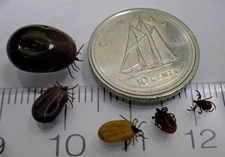Avoiding Lyme-Bacteria-Carrying Deer Ticks
"That's a threshold. Once you know that more than twenty percent of the ticks in your area carry Lyme disease bacteria then we don't need to check in on that [by testing ticks to ascertain whether they're carrying the Lyme bacteria]."
"That is what we now call an 'at-risk area'."
"It's a good-news story, actually, that there is antibiotics that work to treat Lyme disease."
Dr. Vera Etches, Medical Officer of Health, Ottawa Public Health
 |
| Adult female blacklegged tick at various stages of feeding. Photo: Government of Canada |
"So it's really important to take precautions when you're out walking on recreational trails, in wooded areas, particularly those areas with deciduous forests or where you might encounter some deer."
"By understanding some of the driving forces and factors, whether they be environmental or sociological, we can really get a better grasp on how to prevent and control disease."
Manisha Kulkarni, assistant professor, School of Epidemiology and Public Health, University of Ottawa, faculty of medicine
 |
| Researchers from the University of Ottawa hunt for ticks at the Mer Bleue conservation area as they collect data for a three-year tick population study. (Robyn Miller) |
Lyme-carrying ticks are expanding the territory they move into and colonize at the rate of about 46 km annually, according to a 2014 study carried out by the National Collaborating Centre for Infectious Diseases, University of Manitoba. In 2017, over 1,400 cases of Lyme disease were confirmed across Canada with more than two-thirds of those cases in Ontario, assumed to have been locally contracted.
Prior to the last decade, most diagnosed cases in Canada happened in people who were bitten by ticks while travelling in the United States. The ticks' incursions into Canada has been facilitated by changing climate conditions leading to a warming atmosphere. The deer ticks which carry Lyme disease are less likely now to be destroyed by cold winters; they are surviving the moderated cold and more of them are found to be carrying the Lyme bacteria.
Many public health units in Canada make the assumption currently, that if someone is bitten by a tick, they should be treated for Lyme disease, bypassing the past protocol which called for testing ticks in specific areas to determine whether the bacteria causing Lyme disease is present. Public health units have now set aside the testing protocol in the assurance that the bacteria is present on area ticks acting as vectors spreading the disease.
According to Dr. Vera Etches, over a fifth of black-legged (or deer) ticks that were tested registered positive for Lyme. Once an individual finds a tick attached to themselves and has the impression it has been there for over 24 hours, a prescription for antibiotics should be sought to prevent being infected by Lyme -- no testing required. Bacteria in the tick's gut move to its salivary glands and become transferred to a person after a period of 24 hours.
Preventive treatment is ineffective after a lapse of three days. Patients are advised to wait for the appearance of symptoms or to allow sufficient time to elapse for antibodies to evolve that can be detected in a test. Symptoms can take over a month to appear and when they do they can be mistaken for the effects of influenza onset; fever and aches and sometimes a telltale rash. It takes as long for the immune system's antibodies to appear on a lab test.
Untreated, Lyme disease has the potential to cause serious illness such as meningitis. On the good news side, because the condition is bacterial-caused, it is treatable with drugs. Lyme is caused by bacteria traded among black-legged ticks and migratory birds and small mammals such as mice and chipmunks. When birds and small mammals that are infected with the bacteria are bitten by ticks, the ticks become infected and transmit that infection when they in turn bite humans or their pets.
/https://www.thestar.com/content/dam/thestar/news/canada/2019/07/18/lyme-spreading-ticks-so-common-thanks-to-mild-winters-some-places-stop-testing/tick.jpg) |
There are many health benefits from being active and enjoying the outdoors; however, if you are in outdoor areas suitable for ticks, for example, wooded areas or areas with tall grasses, you need to be aware of the risk of Lyme disease. To help prevent Lyme disease, Ottawa Public Health monitors ticks and human illness trends and increases awareness of Ottawa residents of the risks posed by ticks and educates on how to prevent Lyme disease. Preventing tick bites is key to the prevention of Lyme disease, you can do this by:
Ottawa Public Health
- Applying an approved insect repellent containing DEET or icaridin
- Doing a tick check on yourself, your children, and pets
- Checking your pet daily for ticks, especially if it spends time in wooded or overgrown areas
- Removing ticks as soon as possible. If you find a tick on your body, using fine-pointed tweezers, grasp the tick's head as close to the skin as possible and pull slowly until the tick is removed. Do not twist or rotate the tick. Do not use a match, lotion or anything else on the tick.
Labels: Health, Lyme Disease, Research, Ticks

0 Comments:
Post a Comment
<< Home